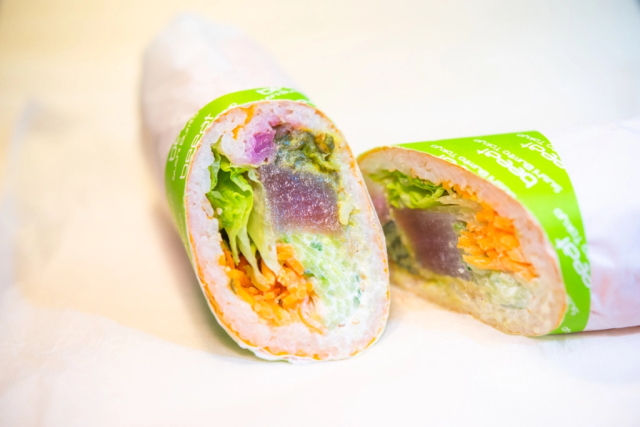
In the biggest sushi-loving town on the planet, can this unique twist on Japan’s food culture succeed?
In some ways, you could argue that Tokyo is the worst place on the planet to open a “sushi burrito” restaurant. Not only is it the capital of the country that created sushi culture, it’s also got the busiest fish market in the world in the Toyosu neighborhood, as well as the prestige of the many sushi restaurants still operating in Tsukiji, where the market was based until just a few months ago.
But on the other hand, you could argue that all will work to the advantage of Beeat, a sushi burrito specialist that just opened in Tokyo on November 30. After all, Tokyo is already packed with traditional sushi restaurants, and rather than compete with them directly, Beeat is offering diners something they can’t get anywhere else in the city.
So we decided to keep an open mind until we’d tried Beeat for ourselves. We sent our Japanese-language reporter Tasuku to do the taste-test honors, since he loves both orthodox sushi and burritos, and was curious to see how Beeat’s sushi burritos, which are really a new type of food rather than a subset of either of their linguistic components, taste.
https://twitter.com/fumitake1969/status/1067772151506202624It’s not just the food that makes Beeat unique, though. Located not far from Akihabara Station (and just down the street from the otaku hair salon we recently visited for a trim), Beeat boasts technological innovations as well. Customers who’re in a hurry can order and pay for their food online, and the restaurant has a futuristic design with numbered compartments where you pick up your meal. Even the pricing is high-tech, with an AI program setting how much the restaurant charges based on market prices for ingredients (prices tend to run between 780 and 1,300 yen [US$6.90 and $11.50] per burrito).
設計監理及び内装デザインを担当した『beeat – Sushi Burrito Tokyo –』が本日グランドオープンしました。簡単に言うと「日本初となる対面無人の寿司ブリトー専門店」です。キャッシュレスやモバイル決済など、近未来型飲食店テクノロジーのショールームでもあります。https://t.co/eHZWpemPDy pic.twitter.com/XUhTv6bRir
— 中郡大輔 (@DCAA_architects) November 30, 2018
▼ Tasuku’s boxed sushi burrito, with his name printed on the label.
Since it was his first visit, Tasuku decided to stuff himself by ordering three different sushi burritos, in order to sample as much of the menu as he possibly could. First up was the Magu Avo Tokyo Road, with top-billing going to its tuna (magura) and avocado.
Beeat’s sushi burritos come pre-cut to make them easier to eat, which also gets you a sneak peek at the ingredients rolled up in them. Along with a generous portion of tuna and avocado, Tasuku’s first course also had shredded carrots, lettuce and cucumber. That’s actually a lot more vegetables than you’d find in a traditional sushi roll, making the sushi burrito a pretty healthy and nutritious option in that regard.
Gourmands will tell you that the word “sushi” indicates not raw fish, but vinegared rice, which Beeat does indeed use as a thin layer, sprinkled with sesame seeds, around the core ingredients. The very outer wrapping isn’t a tortilla, like it would be in a normal burrito, but rather a sort of wrapping like a wanton skin.
Biting into the Magu Avo Tokyo Road, Tasuku discovered there was a slightly tart white sauce on the veggies, which was a little like mayonnaise. Each order at Beeat also comes with three sauces that you can add to taste. The teriyaki went well with the burrito, as did the salsa, but the wasabi sauce was far too spicy even for veteran wasabi-lover Tasuku, who quickly set it aside after it assaulted his tongue and sinuses with its fiery fury. As long as he wasn’t using the wasabi, though, the Magu Avo Tokyo Road was nicely balanced and tasty, with the tuna being of the same tasty quality he’d expect at reasonably priced dedicated sushi restaurants..
Next it was time for the Anago These Dreams.
This is almost exactly the same as the Magu Avo Tokyo Road, with the only differences being a different colored outer wrapping and replacing the tuna with anago (saltwater eel). Since anago is usually a pretty pricy ingredient, Takusu resigned himself to getting only a meager morsel of the expensive seafood, but a pre-tasting examination revealed a nice-sized chunk.
However, anago has a pretty mild flavor, and it wasn’t all that noticeable mixed in with so many other ingredients in the same bite. Things improved considerably when Tasuku added a dash of teriyaki, which is similar, thought not exactly the same as, the sweet sauce often added to the top of pieces of anago nigiri-style sushi.
Finally, to finish things off Tasuku opted for the Omar King of Kings, which seems to be named after the 2006 album from Puerto Rican reggaeton recording artist Don Omar.
The name didn’t really give Tasuku any clue as to what to expect on the ingredient list, and when he opened the box for the Omar King of Kings, he was still confused. There was no white sauce this time, and some shredded pickles had been added o the vegetable mix. But what was the orange thing, seen to the left of the cucumbers in this photo?
There was only one way to find out, so Tasuku took a bite, and as he chewed, he realized that it was a cream croquette which had been compacted and mashed in the burrito rolling process. Personally, he’d have preferred an uncrushed, if smaller, croquette, but once he knew what he was eating, it wasn’t bad.
So what’s Tasuku’s overall take on these sushi burritos? He thinks they’re all tasty, and as long as you don’t have any mental hang-up about the mixing of sushi and burritos (and also a loose definition of burrito, since there are no tortillas here), then you’ll probably enjoy them. “Are you the kind of person who’s OK with California rolls?” he asks. “If so, then yeah, they’re worth trying” (Tasuku himself is a huge California roll fan).
However, if you’re after an authentic sushi experience, sushi burritos probably won’t scratch that itch. Because of that, the Akihabara location gives Beeat an uphill road to success, since the large number of foreign tourists who flood the otaku mecca on a daily basis are primarily there because of a love of Japanese things, and they might find the idea of sushi burritos a little watered-down or weird (or even chu to hampa, to use a Japanese term). On the other hand, these days Akihabara also draws plenty of Japanese travelers and day trippers too, and they might be craving something offbeat before heading back to their hometowns (which also will have plenty of plain old ordinary sushi restaurants), so maybe they’re the ones who’ll ultimately decided whether Beeat keeps going strong.
Restaurant information
beeat Sushi Burrito Tokyo /
Address: Tokyo-to, Chiyoda-ku, Soto Kanda 5-6-2
東京都千代田区外神田5-6-2
Open 11 a.m.-3 p.m.
Website
Photos ©SoraNews24
[ Read in Japanese ]

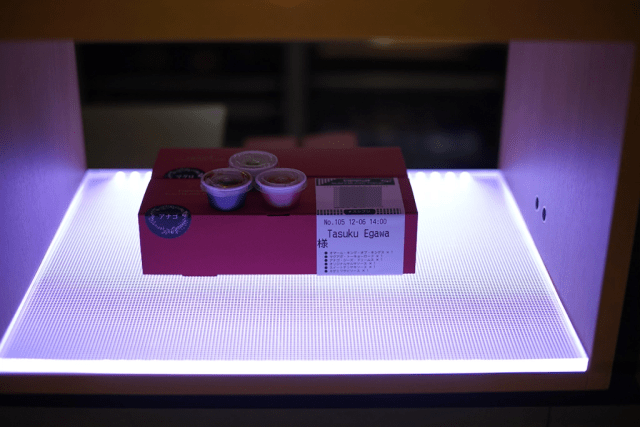
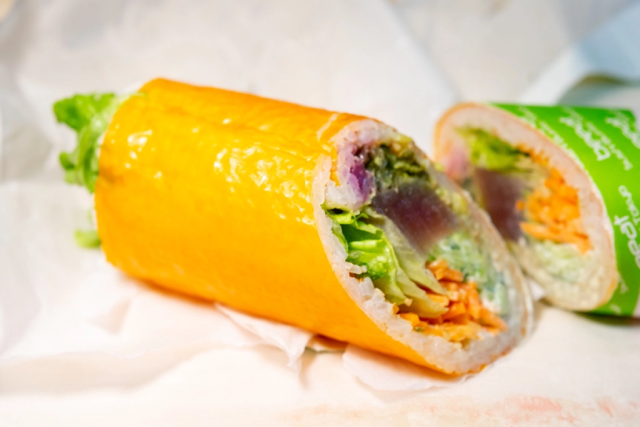
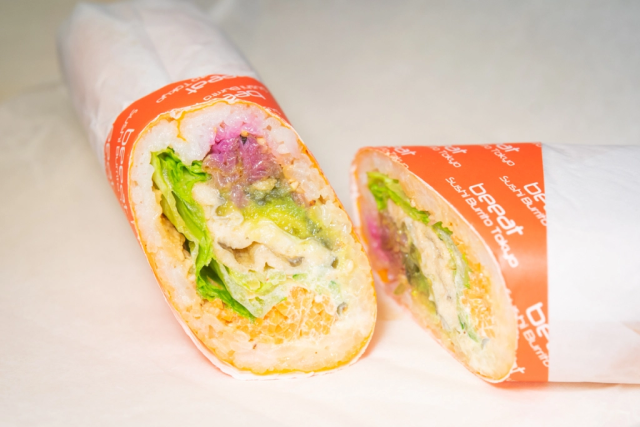
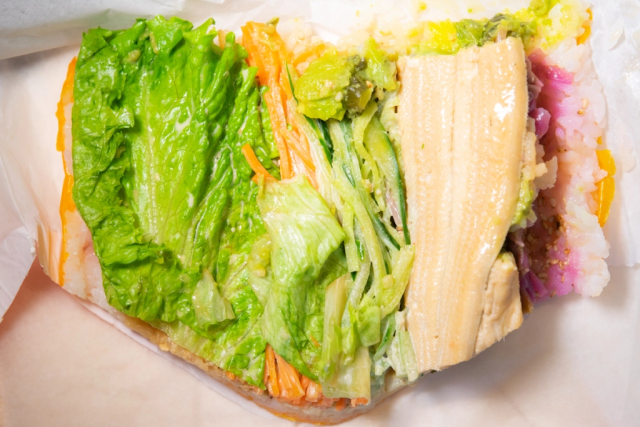


 What, there’s now a specialty burrito shop in Tokyo? Of course, we had to go try it ourselves!
What, there’s now a specialty burrito shop in Tokyo? Of course, we had to go try it ourselves! Butter on sushi? We’d heard it was great, but we wouldn’t believe it without trying it ourselves
Butter on sushi? We’d heard it was great, but we wouldn’t believe it without trying it ourselves We try vegetarian sushi at Tokyo’s newest sushi train restaurant 【Pics & Taste Test】
We try vegetarian sushi at Tokyo’s newest sushi train restaurant 【Pics & Taste Test】 How to use the self-serve dispensers for green tea at conveyor bel sushi restaurants in Japan
How to use the self-serve dispensers for green tea at conveyor bel sushi restaurants in Japan Osaka’s Okonomiyaki Burrito is both classic Taco Bell and completely different【Taste test】
Osaka’s Okonomiyaki Burrito is both classic Taco Bell and completely different【Taste test】 Tokyo cafe offers all-you-can-eat pancakes for less than ten bucks!
Tokyo cafe offers all-you-can-eat pancakes for less than ten bucks! That time Seiji called JASRAC to ask why he didn’t get paid royalties for his song being on TV
That time Seiji called JASRAC to ask why he didn’t get paid royalties for his song being on TV Eating all the cat treats at Japanese convenience store Family Mart
Eating all the cat treats at Japanese convenience store Family Mart Pikachu-ear engagement rings and Pokémon wedding rings for him and her can now be yours【Photos】
Pikachu-ear engagement rings and Pokémon wedding rings for him and her can now be yours【Photos】 7-Eleven Japan’s ramen-cooking robot whipped us up a bowl of noodles【Taste test】
7-Eleven Japan’s ramen-cooking robot whipped us up a bowl of noodles【Taste test】 Harajuku’s new permanent Tamagotchi shop is filled with cuteness and a surprising lack of poop
Harajuku’s new permanent Tamagotchi shop is filled with cuteness and a surprising lack of poop First Kit Kat Chocolatery shop with cafe opens in Kyoto! New Chocolatery items released too
First Kit Kat Chocolatery shop with cafe opens in Kyoto! New Chocolatery items released too The roller slide of terror: Treetop fun ride for kids is a terrifying experience for adult butts
The roller slide of terror: Treetop fun ride for kids is a terrifying experience for adult butts Cup Noodle tries an authentic Jiro-style ramen, but something’s not quite right
Cup Noodle tries an authentic Jiro-style ramen, but something’s not quite right 17 new designs unveiled in round two of regional Japanese license plates
17 new designs unveiled in round two of regional Japanese license plates Starbucks Japan ready to get Year of the Horse started with adorable drinkware and plushies【Pics】
Starbucks Japan ready to get Year of the Horse started with adorable drinkware and plushies【Pics】 7 great places to see Mt. Fuji from without having to climb it
7 great places to see Mt. Fuji from without having to climb it Cyberpunk anime meets traditional culture in Ghost in the Shell gold leaf Japanese changing screens
Cyberpunk anime meets traditional culture in Ghost in the Shell gold leaf Japanese changing screens Hayao Miyazaki says Happy New Year to Studio Ghibli fans with new art for Year of the Horse
Hayao Miyazaki says Happy New Year to Studio Ghibli fans with new art for Year of the Horse Hello Kitty Choco Egg figures are an adorable trip through three periods of Japanese pop culture【Pics】
Hello Kitty Choco Egg figures are an adorable trip through three periods of Japanese pop culture【Pics】 We found possibly the quietest Japanese-style hotel in Tokyo’s bustling Shinjuku district
We found possibly the quietest Japanese-style hotel in Tokyo’s bustling Shinjuku district Sumo Sanrio! Hello Kitty and pals team up with Japan Sumo Association for new merch【Pics】
Sumo Sanrio! Hello Kitty and pals team up with Japan Sumo Association for new merch【Pics】 Japan’s oldest largetooth sawfish in captivity back on display in Mie Prefecture
Japan’s oldest largetooth sawfish in captivity back on display in Mie Prefecture More Than a Capsule Stay: Why Solo Travelers Choose “global cabin Yokohama Chinatown”
More Than a Capsule Stay: Why Solo Travelers Choose “global cabin Yokohama Chinatown” 7-Eleven Japan starts new temporary luggage storage service in over 300 branches
7-Eleven Japan starts new temporary luggage storage service in over 300 branches Disillusionment at Tsukiji’s tourist-target prices led us to a great ramen restaurant in Tokyo
Disillusionment at Tsukiji’s tourist-target prices led us to a great ramen restaurant in Tokyo Starbucks teams up with 166-year-old Kyoto doll maker for Year of the Horse decorations【Photos】
Starbucks teams up with 166-year-old Kyoto doll maker for Year of the Horse decorations【Photos】 Tokyo considering law requiring more trash cans following litter increase in heavily touristed area
Tokyo considering law requiring more trash cans following litter increase in heavily touristed area Tokyo’s Tsukiji sushi neighborhood asks tour groups to stay away for the rest of the month
Tokyo’s Tsukiji sushi neighborhood asks tour groups to stay away for the rest of the month Tokyo event lets you travel back in time, for free, to celebrate 100 years since Showa era start
Tokyo event lets you travel back in time, for free, to celebrate 100 years since Showa era start Sanrio theme park in Japan announces plans to expand into a Sanrio resort
Sanrio theme park in Japan announces plans to expand into a Sanrio resort Japan may add Japanese language proficiency, lifestyle classes to permanent foreign resident requirements
Japan may add Japanese language proficiency, lifestyle classes to permanent foreign resident requirements Stamina-destroying “Paralysis Noodles” are Tokyo’s newest over-the-top ramen innovation
Stamina-destroying “Paralysis Noodles” are Tokyo’s newest over-the-top ramen innovation Survey asks foreign tourists what bothered them in Japan, more than half gave same answer
Survey asks foreign tourists what bothered them in Japan, more than half gave same answer Japan’s human washing machines will go on sale to general public, demos to be held in Tokyo
Japan’s human washing machines will go on sale to general public, demos to be held in Tokyo Japan’s deadliest food claims more victims, but why do people keep eating it for New Year’s?
Japan’s deadliest food claims more victims, but why do people keep eating it for New Year’s? We deeply regret going into this tunnel on our walk in the mountains of Japan
We deeply regret going into this tunnel on our walk in the mountains of Japan Studio Ghibli releases Kodama forest spirits from Princess Mononoke to light up your home
Studio Ghibli releases Kodama forest spirits from Princess Mononoke to light up your home Major Japanese hotel chain says reservations via overseas booking sites may not be valid
Major Japanese hotel chain says reservations via overseas booking sites may not be valid Put sesame oil in your coffee? Japanese maker says it’s the best way to start your day【Taste test】
Put sesame oil in your coffee? Japanese maker says it’s the best way to start your day【Taste test】 No more using real katana for tourism activities, Japan’s National Police Agency says
No more using real katana for tourism activities, Japan’s National Police Agency says Starbucks Japan reveals new sakura drinkware collection, inspired by evening cherry blossoms
Starbucks Japan reveals new sakura drinkware collection, inspired by evening cherry blossoms Updated cherry blossom forecast shows extra-long sakura season for Japan this year
Updated cherry blossom forecast shows extra-long sakura season for Japan this year Which Japanese conveyor belt sushi chain has the best saltwater eel sushi?【Taste test】
Which Japanese conveyor belt sushi chain has the best saltwater eel sushi?【Taste test】 Our Japanese-born reporter eats burrito for first time in his life, changes opinion on McDonald’s
Our Japanese-born reporter eats burrito for first time in his life, changes opinion on McDonald’s Sushi chains Sushiro and Kyotaru combine to make fishy megastore, but we spot major oversight
Sushi chains Sushiro and Kyotaru combine to make fishy megastore, but we spot major oversight Horse meat sushi restaurant opens up in Tokyo, becomes sushi’s latest craze 【Photos】
Horse meat sushi restaurant opens up in Tokyo, becomes sushi’s latest craze 【Photos】 We try out a pricier revolving sushi chain only available close to the sea in Fukui prefecture
We try out a pricier revolving sushi chain only available close to the sea in Fukui prefecture Tokyo has a BLUE sushi restaurant with all-you-can-eat BLUE sushi for just 400 yen (US$3.50)
Tokyo has a BLUE sushi restaurant with all-you-can-eat BLUE sushi for just 400 yen (US$3.50) Who’s got the best, cheapest one-person sushi delivery in downtown Tokyo? Mr. Sato investigates!
Who’s got the best, cheapest one-person sushi delivery in downtown Tokyo? Mr. Sato investigates! We eat fugu pufferfish semen at a Japanese restaurant in Tokyo
We eat fugu pufferfish semen at a Japanese restaurant in Tokyo Want to eat ramen and sushi together? New restaurant in Tokyo makes culinary dreams come true
Want to eat ramen and sushi together? New restaurant in Tokyo makes culinary dreams come true Handsome host sushi bar opens in Tokyo with 14-year host veteran pressing the pieces
Handsome host sushi bar opens in Tokyo with 14-year host veteran pressing the pieces How to get an amazing Sukiyabashi Jiro sushi lunch for less than 15 bucks
How to get an amazing Sukiyabashi Jiro sushi lunch for less than 15 bucks New sushi restaurant hidden inside Tokyo Station is a secret gem
New sushi restaurant hidden inside Tokyo Station is a secret gem We try Keiji, an incredibly rare and expensive one-in-ten-thousand salmon sushi 【Taste test】
We try Keiji, an incredibly rare and expensive one-in-ten-thousand salmon sushi 【Taste test】 Tokyo’s first sushi cake specialty store opens in Japan
Tokyo’s first sushi cake specialty store opens in Japan Haneda Market: Tokyo Station conveyor belt sushi restaurant is special on two days of the week
Haneda Market: Tokyo Station conveyor belt sushi restaurant is special on two days of the week
Leave a Reply